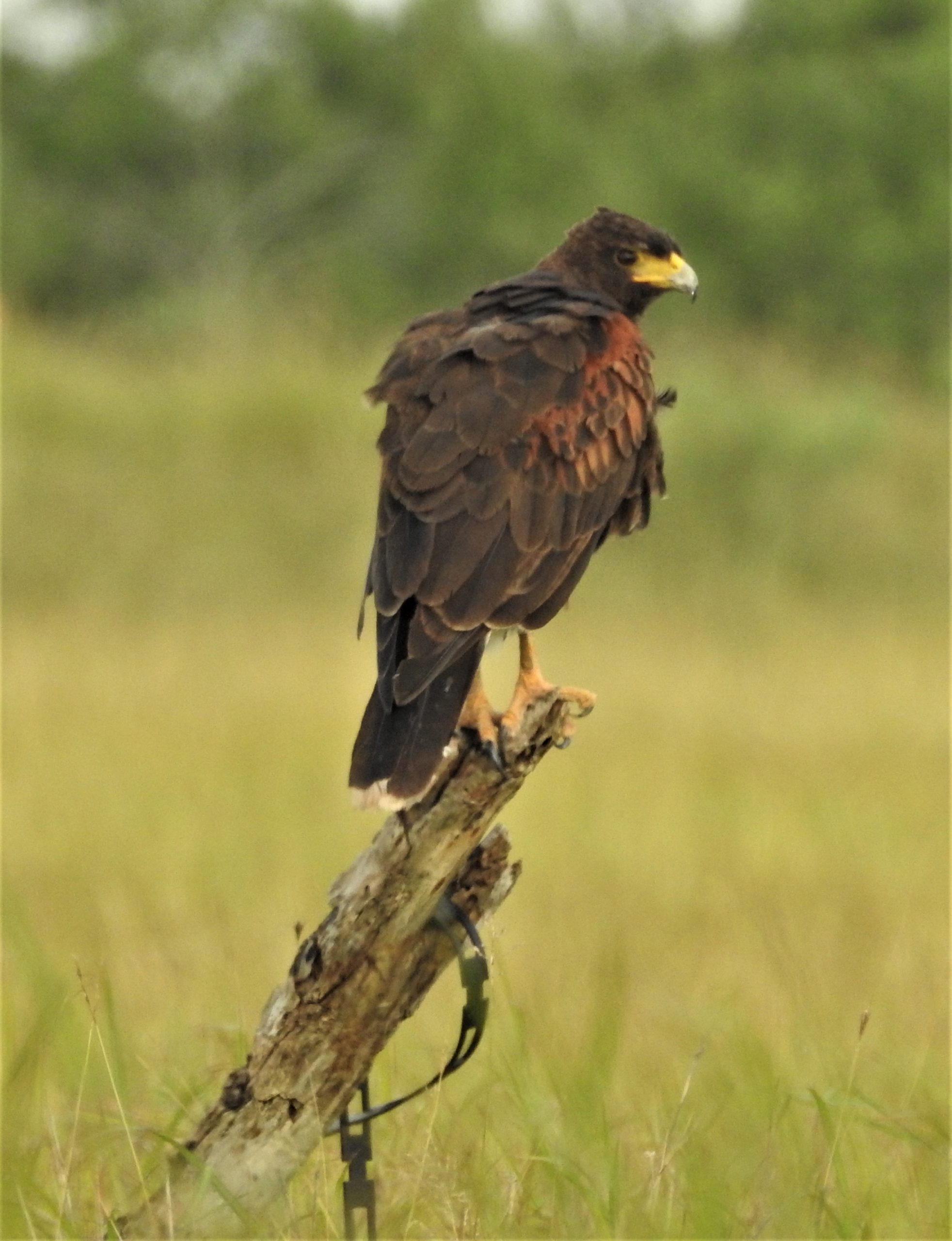by M. Kathy Raines

Like no-nonsense lifeguards perched along a shoreline, Harris’s hawks scrutinize grasslands from multi-tiered poles and brush piles along the Brownsville Historic Battlefield Trail of an evening—sometimes two or three raptors to a pole.
Stern and stunning, with brutal weaponry and luminous chestnut and chocolate plumage, their intent glares overlook nothing—certainly not me, as I dismount my bicycle and fasten them in the gaze of my binoculars and camera. If I keep my visit short and my distance substantial, they tolerate me as either a possible threat or a lumbering nuisance. Recently, two juvenile Harris’s hawks, with the brazenness of youth, occupied a pole, chattering with one another as I knelt underneath, snapping photo-after-photo.
On the trail at dusk, I often see five or six Harris’s hawks soaring or on the lookout. Sociable birds, they occasionally perch atop one another for a few minutes. Other evenings, I see nary a hawk. Curious and opportunistic, hawks will closely attend to a train rumbling down nearby tracks.
This summer, Harris’s hawks ruled the mesquite-patched fields, accompanied by a few white-tailed kites. This fall and winter, though, northern harriers, red-tailed hawks and American kestrels joined them in picking off the abundant creatures of the grasslands.
Harris’s hawks favor medium-sized prey, including rabbits, squirrels, rats, reptiles and birds. Most commonly, these raptors scan for prey from trees, snags and utility poles, often fluttering from perch-to-perch. Spotting a victim, a hawk swoops down upon it.
From the Paredes Line overpass, I have happened upon the same female, whose green band clearly reveals her number, several times last year. I reported the sighting to this website: https://www.pwrc.usgs.gov/BBL/bblretrv/. Andrea Gibbons, a graduate student at the University of North Texas who is investigating Harris’s hawks’ colonial nesting habits, informed me that this female was banded nearby two years prior. I am heartened the hawk is thriving.
Harris’s hawks flourish in Texas brushlands, semi-open deserts, savannahs and some wetlands.
Likened to wolf packs, Harris’s hawks often breed and hunt communally. Adaptable creatures, they may nest at any time but most regularly breed in the spring. With one couple forming an alpha pair, as many as seven adults may hunt together and safeguard the young.
A cooperative hunt often begins with an assembly of hawks perching together. They may attack prey from different directions, and a hawk or two may flush out quarry while others mount an ambush. Sometimes two birds converge on a victim simultaneously. In pursuing a fleeing rabbit, hawks may, like in a relay race, rush to replace one another. They sometimes cache prey in trees to eat later.
These collaborative hunts, seemingly more successful than solitary ones, apparently occur more frequently when prey is scarce. Also, hunting in groups can decrease injuries. A robust kick from a jackrabbit can kill a lone Harris’s hawk. These hawks’ propensity to work together endears them to falconers.
Though Harris’s hawk populations do not greatly worry conservationists, the birds’ numbers, according to the North American Breeding Bird Survey, have declined about 2% between 1968 and 2015—likely due to increasing urbanization and mineral development. So much arboreal habitat has dwindled that hawks increasingly perch on utility poles, which puts them at risk for electrocution.
Watching Harris’s hawks in the fallow fields of the bike trail during the relative isolation wrought by the pandemic has brought utter joy. I thank the hawks for the privilege.


